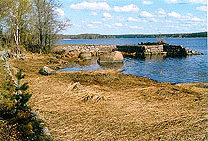|
SEA FORTIFICATIONS OF THE VYBORG FORTRESS

Marine fortifications of the Vyborg fortress had been created since the beginning of the XVIII century,
after the moment when Russia got an outlet to the Baltic sea, as the result of the Northern war,
in order to defend the city and sea borders of the Russian state.
Along with city's fortifications they make a kind of "encyclopaedia" of the European and Russian
military engineering skill.
The question about creation of Vyborg Marine fortifications
was raised for the first time during Northern War, when this
town became a member of Russian empire.
Before that, from the end of XIII centure till the beginning of
XVIII century Vyborg was Swedish fortress on the Western
coast of the Baltic Sea. The sea considered to be Swedish
inner sea.
Attention mostly was paid to the defence of the continent, at
the side of Karelian neck. That was a big mistake of Swedes
- they couldn't forsee the appearance of Russian fleet from
Baltia. Decisive role of the fleet in successful siege in the
capture of Vyborg in 1710 year is known very well.
To counteract this marine operation of Swedes first coastal
battery was erected by Peter I instruction - in small island
Harkisaari at nearest approaches to Vyborg.
During the Nothetn War of 1788-1790 years a new defensive
line was created on yhe islands of Tranzund archipelago.
During the next Russian - Swedish war (1807-1809 years)
maritime position was strengthened by six supplementary
batteries. The arming of the batteries was formed by 81 guns.
Position's selection (with moving out of shore's line, as a
rule, to main line of resistance) was caused by a long-range
ability of the guns (nearly 0.3 km) and by necessity to resist
the galley fleet.
When Finland joined Russian empire Vyborg reserved the
meaning of the important Baltic fortress though to modernize
this fortress waspaid very little attention till the middle of XIX
century. During the Crimean War urgent measures took place
to intensify maritime positions.
In 1855 year two defensive lines were created with a new
location of the batteries.
The arming of the batteries consisted of 52 guns. The general
guidance under this project was carried out by V.D.Krenke.
According to a new scheme the first line's batteries were
disposed near the inner outlets from the strates., where the
manocurability of the enemy's sheeps was extremely limited.
All that fortification buildings related to the epoch of
smooth-bore artillery and sailing ships.
The appearence of steam and iron ships, refinement of an
artillery after the Crimean war demanded to strengthen the
defensive means of Russian fortresses. In 1860-1870 years
a new land position was built on the stony hills at the East
side of Vyborg. It was formed by four redoubts with 3
intermediate batteries and forward fortifications as a bastion
front.
Threenew batteries were built to defend the approaches to
Vyborg from the West. With the increasing of the fortress's
outlining major apart of the old town fortifications lost its
meaning and was demolished.
This is unique museum of military history especially nowadays, when a great number of memorials
of Russian fortification left behind the Russian borders.
|

